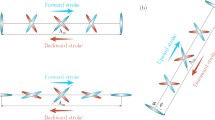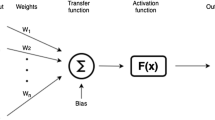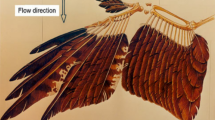Abstract
Miniaturization and improved performance of computers, sensors, and executive devices open up new possibilities for intelligent control over complex mechatronic systems on transition processes and under turbulence. Previously, adaptive control problems in a changing environment and with state space structure changing in time have virtually not been studied due to limited capabilities for a practical implementation. The change of the state space structure (dimension) is possible under active interaction with the environment. In this work, with the example of an airplane with a large number of “feathers” distributed on the surface, i.e., elements with pressure sensors and executive turning devices, we show that in complex systems adaptation to changes in the structure of external disturbances can be done with internal selforganization, similar to multiagent systems. Under turbulence, to solve the problem of equating the influence of disturbing forces on different elements of the wing and transforming airplane flow to a mode close to laminar, we have considered the possibility to apply a multiagent protocol. The operability of the new approach is illustrated with a specially made experimental testbed that allows for real physical experiments.
Similar content being viewed by others
References
Granichin, O. and Khantuleva, T., Hybrid Systems and Randomized Measuring in Nonequilibrium Processes, Differ. Equat. Control Process, 2004, no. 3, pp. 35–43.
Sinai, Ya.G., Constructing Cluster Dynamics for Dynamical Systems of Statistical Mechanics, Vestn. Mosk. Gos. Univ., Ser. Mat. Mekh., 1974, vol. 29, no. 1, pp. 152–158.
Meshcheryakov, Yu.I. and Khantuleva, T.A., Nonequilibrium Processes in Condensed Media: Part 1. Experimental Studies in Light of Nonlocal Transport Theory, Phys. Mesomech., 2015, vol. 18, no. 3, pp. 228–243.
Khantuleva, T.A. and Meshcheryakov, Yu.I., Nonequilibrium Processes in Condensed Media. Part 2. Structural Instability Induced by Shock Loading, Phys. Mesomech., 2016, vol. 19, no. 1, pp. 69–76.
Pashkevich, V.V., Meier, P., Brack, M., and Unzhakova, A.V., Semiclassical Analysis of the Lowest-Order Multipole Deformations of Simple Metal Clusters, Phys. Lett. A, 2002, vol. 294, pp. 314–318.
Unzhakova, A.V., Khantuleva, T.A., and Granichin, O.N., Cluster Degrees of Freedom in Fission of Actinides, in Fission and Properties of Neutron-Rich Nuclei, Proc. 6th Int. Conf. ICFN6, 2017.
Zubarev, D.N., Neravnovesnaya statisticheskaya termodinamika (Nonequilibrium Statistical Thermodynamics), Moscow: Nauka, 1971.
Khantuleva, T.A., Nelokal’naya teoriya neravnovesnykh protsessov perenosa (Nonlocal Theory of Nonequilibrium Transfer Processes), St. Petersburg: S.-Peterburg. Gos. Univ., 2013.
Vavilov, S.A., A Method of Studying the Existence of Nontrivial Solutions to Some Classes of Operator Equations with an Application to Resonance Problems in Mechanics, Nonlin. Anal., 1995, vol. 24, no. 5, pp. 747–764.
Fradkov, A.L., Horizons of Cybernetical Physics, Philos. Trans. Royal Soc. A: Math. Phys. Eng. Sci., 2017, vol. 375, no. 2088, 20160223.
Khantuleva, T.A. and Shalymov, D.S., Modelling Non-equilibrium Thermodynamic Systems from the Speed-Gradient Principle, Philos. Trans. Royal Soc. A, 2017, vol. 375, no. 2088, 2016220.
Emel’yanov, S.V., Sistemy avtomaticheskogo upravleniya s peremennoi strukturoi (Automated Control Systems with Variable Structure), Moscow: Nauka, 1967.
Utkin, V.I., Sliding Modes in Control and Optimization, Berlin: Springer-Verlag, 1992.
Olfati-Saber, R., Fax, J., and Murray, R., Consensus and Cooperation in Networked Multi-Agent Systems, Proc. IEEE, 2007, vol. 95, no. 1, pp. 215–233.
Ren, W., Beard, R., and Atkins, E., Information Consensus in Multivehicle Cooperative Control, IEEE Control Syst., 2007, vol. 27, no. 2, pp. 71–82.
Chebotarev, P.Yu. and Agaev, R.P., Coordination in Multiagent Systems and Laplacian Spectra of Digraphs, Autom. Remote Control, 2009, vol. 70, no. 3, pp. 469–483.
Amelina, N.O., Scheduling Networks with Variable Topology in the Presence of Noise and Delays in Measurements, Vestn. S.-Peterburg. Gos. Univ., Mat., Mekh., Astron., 2012, vol. 45, no. 2, pp. 56–60.
Lewis, F., Zhang, H., Hengster-Movric, K., et al., Cooperative Control of Multi-Agent Systems: Optimal and Adaptive Design Approaches (Communications and Control Engineering), New York: Springer, 2014.
Proskurnikov, A.V. and Cao, M., Synchronization of Goodwin’s Oscillators under Boundedness and Nonnegativeness Constraints for Solutions, IEEE Trans. Automat. Control, 2017, vol. 62, no. 1, pp. 372–378.
Granichin, O., Khantuleva, T., and Granichina, O., Local Voting Protocol for the Adaptation of Airplane’s “Feathers” in a Turbulence Flow, Proc. 2017 Am. Control Conf., Seattle, May 24–26, 2017, pp. 5684–5689.
Amelina, N.O. and Fradkov, A.L., Approximate Consensus in the Dynamic Stochastic Network with Incomplete Information and Measurement Delays, Autom. Remote Control, 2012, vol. 73, no. 11, pp. 1765–1783.
Amelina, N., Fradkov, A., Jiang, Y., et al., Approximate Consensus in Stochastic Networks with Application to Load Balancing, IEEE Trans. Inform. Theory, 2015, vol. 61, no. 4, pp. 1739–1752.
Ligum, T.I., Aerodinamika i dinamika poleta turboreaktivnykh samoletov (Aerodynamics and Flight Dynamics of Turbo-Jet Airplanes), Moscow: Transport, 1967.
Granichin, O., Khantuleva, T., and Amelina, N., Adaptation of Aircraft’s Wings Elements in Turbulent Flows by Local Voting Protocol, Proc. 20th World Congr. Int. Federation of Automatic Control, Toulouse, France, 9–14 July 2017, pp. 1940–1945.
Klimontovich, Yu.L., Turbulentnoe dvizhenie i struktura khaosa (Turbulent Motion and Structure of Chaos), Moscow: Nauka, 1990.
Zhuravlev, V.F., Osnovy teoreticheskoi mekhaniki (Fundamentals of Theoretical Mechanics), Moscow: Fizmatlit, 2001, 2nd ed.
Amelina, N.O., Multiagent Technologies, Adaptation, Self-Organization, Achieving Consensus, Stokh. Optimiz. Informatik., 2011, vol. 7, no. 1, pp. 149–185.
Fradkov, A.L., Investigation of Physical Systems by Feedback, Autom. Remote Control, 1999, vol. 60, no. 3, pp. 471–483.
Kalmuk, A., Granichin, O., Granichina, O., et al., Detection of Abrupt Changes in Autonomous System Fault Analysis Using Spatial Adaptive Estimation of Nonparametric Regression, Proc. 2016 Am. Control Conf., Boston, July 6–8 2016, pp. 6839–6844.
Granichin, O.N., How Are Complex Information–Control Systems Actually Structured? Stokh. Optimiz. Informat., 2016, vol. 12, no. 1, pp. 3–19.
Granichin, O. and Amelina, N., Simultaneous Perturbation Stochastic Approximation for Tracking under Unknown but Bounded Disturbances, IEEE Trans. Automat. Control, 2015, vol. 60, no. 6, pp. 1653–1658.
Amelin, K. and Granichin, O., Randomized Control Strategies under Arbitrary External Noise, IEEE Trans. Automat. Control, 2016, vol. 61, no. 5, pp. 1328–1333.
Granichin, O.N., Amelin, K.S., and Amelina, N.O., Invention Claim, Aerodynamic Wing of a Flying Vehicle with Adaptive Changing Surface, no. 2016147133/20(075649), 30.11.2016.
Amelin, K., Amelina, N., Ivanskiy, Y., et al., Choice of Step-Size for Consensus Protocol in Changing Conditions via Stochastic Approximation Type Algorithm, Proc. 2016 Int. Conf. on Control, Decision and Information Technologies (CoDIT), 2016, pp. 7–11.
Author information
Authors and Affiliations
Corresponding author
Additional information
Original Russian Text © O.N. Granichin, T.A. Khantuleva, 2017, published in Avtomatika i Telemekhanika, 2017, No. 10, pp. 168–188.
Rights and permissions
About this article
Cite this article
Granichin, O.N., Khantuleva, T.A. Adapting wing elements (“feathers”) of an airplane in a turbulent flow with a multiagent protocol. Autom Remote Control 78, 1867–1882 (2017). https://doi.org/10.1134/S0005117917100101
Received:
Published:
Issue Date:
DOI: https://doi.org/10.1134/S0005117917100101




